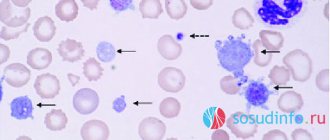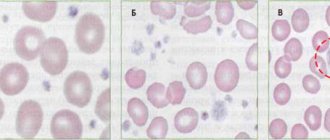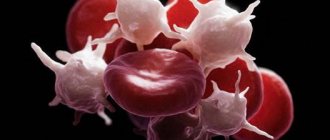The hematopoietic system is a very delicate structure. Despite quite a lot of endurance, it quickly goes into dysfunctional mode. The threshold for the development of pathology is high, but once a disorder occurs, the body is practically unable to cope on its own.
As part of the diagnosis, a method such as studying the average platelet volume is used (the norms are presented here). This complex term refers to the ratio of mature and unready formed cells. Otherwise, the indicator is designated as MPV. It is also present in a standard blood test.
If the average platelet volume is increased, this means that immature types predominate in the bloodstream - they leave the bone marrow too quickly and are abnormally large in size or shape. It is clear that such cells cannot perform the functions that lie on them.
The further the MPV indicator moves above the permissible limit of the norm (this is 12.1 fL), the more serious the violations. Objectively, the disease manifests itself as coagulopathies and slow coagulation.
Treatment is not always necessary. Sometimes the disorder occurs spontaneously, under the influence of physiological factors. But it is possible to assert that the process is “normal” only after diagnosis.
The essence of the disorder and the mechanism of its development
The disorder is based on a group of pathogenetic factors. As a rule, they are not found in the system. Most often, one specific “culprit” is found in the patient.
Unfavorable heredity
The bone marrow works according to a pattern predetermined before birth. Its functionality and “sensitivity threshold”, endurance are determined genetically.
If the parents' material was defective, there is a high probability that the patient himself will encounter problems. The reason is mutations.
They are not always caused by genetic mechanisms themselves, inheritance.
Spontaneous processes often occur when the material itself is damaged. For example, after the mother suffered an infectious disease in the early stages, etc.
Chronic inflammatory processes
Not necessarily septic. Autoimmune forms are also possible. In this case, the average platelet volume increases due to the production of prostaglandins and other substances. Typical inflammatory mediators.
They perform the main role: they drive blood to the affected area, but there is also a downside. These compounds inhibit the functioning of the bone marrow and reduce the rate of maturation of formed cells. Therefore, it is impossible to achieve recovery without high-quality correction of inflammation.
Functional bone marrow diseases
That is, disorders that are not associated with damage to this structure. Anatomical integrity and other factors remain intact. Only the abilities and capabilities of the tissues suffer.
This happens for various reasons. If a person takes antibiotics, he receives cytostatics. Patients with radiation sickness are also at risk of experiencing bone marrow suppression. Not necessarily in a complex form.
Sometimes there are no external manifestations of radiation damage at all. The high-risk group includes workers at nuclear power plants, the mining industry, etc.
Body structure disorders
For example, after removal of the spleen. This organ is a depot for platelets and more. That is, it accumulates formed cells and, if necessary, releases them into the blood.
It is quite possible that the disease has existed for a long time, the body has simply learned to compensate for the disorder. As soon as such an important “storage” disappears, pathology rises to its full extent.
Sometimes it is not possible to determine the mechanism at all. In this case, doctors talk about an idiopathic decrease in the average platelet volume. An indeterminate diagnosis is reviewed as soon as new information becomes available.
This is not an independent type of pathology, but rather an insufficient diagnostic result and a partial description of the disease. It will be clarified in the future. It is the matter of time.
What are platelets?
Platelets are cells that play an important role in blood clotting. They are small, spherical blood cells that do not contain nuclei, whose main function is to stop bleeding. Platelets are produced in the bone marrow and come from cells called megakaryocytes. Megakaryocytes are very large in size, but at some point they break down to produce more than 1,000 platelets that enter the bloodstream. To stop bleeding, platelets gather together at the site of endothelial damage. They connect with each other and form a blood clot. This process has the following steps:
- Adhesion – in response to vascular damage, platelets bind to specific receptors on the damaged endothelium.
- Activation - the shape of platelets changes, their receptors are activated and specific chemicals are released.
- Aggregation - platelets connect to each other through receptor binding.
Simply put, platelets are essential for normal blood clotting. Coagulation (blood clotting) is the process by which blood clots form in the blood, due to which the body loses less blood when blood vessels are damaged. Coagulation disorders may lead to an increased risk of bleeding or blood clots.
Reasons for the increase and what treatment is needed in different cases
MPV never goes down on its own; there are no natural culprits. Provocateurs are always pathological.
Endocrine diseases
Volumetric layer of diagnoses. Due to the complex localization and variety of possible problems, diagnosis becomes quite difficult.
- Increased concentration of thyroid hormones. Or thyrotoxicosis. Happens frequently. Accompanied by typical symptoms: increased body temperature, blood pressure, and other manifestations.
However, the most important thing remains beyond attention: with thyrotoxicosis, the average platelet volume increases, the number of immature cells increases.
Due to structural defects and abnormally large sizes, they are not able to work as they should. This means their existence is useless. While there are significantly fewer normal platelets.
Treatment: You won’t be able to cope with the problem on your own. Need medicine. To correct hormone levels, iodine preparations are prescribed, and a diet with a reduced content of this microelement is also required.
Hormone levels are measured every week or slightly less often. The criterion for effectiveness is a drop in the concentration of T3, T4. Specific substances of the thyroid gland.
- Diabetes. Classic disease. The amount of insulin decreases or the tissues do not sufficiently perceive the effect of the substance. As a result, glucose levels rise.
In this pathological process, all tissues and organs are affected. From the circulatory system to nerve clusters, cerebral structures.
The average platelet volume increases for natural reasons - this is the result of complex dysfunction of the body.
Treatment: constant sugar control. Insulin should be used as needed. You also cannot do without a special diet with a minimum of fast carbohydrates. This means you need to consume less sugar, flour products, and starch.
Attention:
Once or twice a year, the patient is required to visit an endocrinologist to adjust treatment and check the condition of the body. It's a matter of survival.
Not enough is known about how the quality of the hematopoietic system is affected by other endocrine diseases. Doctors are studying this issue.
Early postoperative period
Regardless of the type and duration of the intervention. The point is different. Injuries, especially those that the body receives during surgical treatment, cause activation of all systems. The platelets literally go crazy trying to close the wounds. It is clear that after surgery the concentration of cells increases.
This is ideal ground for the development of complications. If there is at least a minimal predisposition to hematopoietic disorders, problems cannot be avoided. Because during the recovery period, the bone marrow functions in emergency mode.
Ultimately, it may not be able to withstand the load and will begin to release immature forms of platelets. The best time to check this is the first few days after surgery. In general, this phenomenon is quite normal. Everything recovers on its own after a week or a little more.
The situation is worse if the operation is aimed at changing the configuration of the hematopoietic system. We are talking about removing the spleen. As already mentioned, this organ is responsible for the accumulation of formed cells. Such storage helps compensate for disturbances and reduces the load on the hematopoietic system and bone marrow during emergency situations.
It is impossible to predict exactly what will trigger a failure. After the spleen is removed, the body becomes vulnerable. The risk of encountering hematopoietic disorders is much higher.
There is no specific treatment. It is enough to take a general blood test once every six months. If the patient is predisposed to diseases of this type, then regular consultations with a hematologist will not hurt. Then the doctors decide all the issues. Depends on a situation.
Hereditary diseases
The reasons for the increase in average platelet volume in adults and children may also be genetic. This is relatively rare. We can talk about two main options:
- The parents' source material was defective. Consequently, the child gets the disease in a dominant or recessive way.
- Everything is fine with the fund, a spontaneous mutation occurred. Often the mother herself is to blame: smoking, drinking alcohol, and other bad habits do not add health to the fetus. Although there are exceptions. Environmental factors, the quality of water, food, and air make their negative contribution.
Regardless of what caused it, the outcome is always the same: permanent impairment. How heavy is an individual question.
It is possible to correct the symptoms, but it will not be possible to cope with the primary source. The problem is encoded in the foundation of the body. This is an integral part of it.
Tumors
In the early stages of the neoplastic process, when the tumor is still growing, the average platelet volume may already be more than 12.4-12.7 femtoliters. This is a non-specific sign.
Of course, it is impossible to judge by it alone. But it wouldn’t hurt to pay attention to the deviation. The cause needs to be clarified using instrumental methods.
The location and type of tumor do not matter. But the stage of cancer plays a big role. The larger the neoplasia, the more voracious it is, the higher the MPV.
This happens because education is falling apart. The cells eat so much that there is not enough for everyone. The process of natural death from dystrophy begins. Open wounds form. Platelets rush to plug the gap and so on in a circle. At the final stages, there are practically no mature cells left. Hematopoiesis completely goes into abnormal mode.
Treatment. The tumor must be removed as soon as possible. Preferably totally. That is, so that not a single foreign cell remains.
If necessary, doctors prescribe radiation and chemotherapy. Then dynamic regular monitoring is indicated. If a relapse develops, the series is repeated.
This won't be enough. Because the drugs used to treat cancer themselves depress the bone marrow. The situation gets even worse. That's why special drugs are used. They enhance the production of formed cells and stimulate the bone marrow to work more actively. For example, Etamzilat.
Inflammation
Infectious or autoimmune. This does not play a big role, since in both cases the result is the same. Mediator substances inhibit the functioning of the bone marrow. Platelets are not synthesized in sufficient quantities. Their maturation is disrupted.
Treatment. Depends on the situation. Infectious processes themselves are very heterogeneous.
- When affected by bacteria, antibiotics are needed. Moreover, those to which the agent has no resistance.
- In case of viral infection, special stimulators of interferon production will be required.
- Fungi are sensitive to fungicides.
Other medications are also used as a support measure. If the source is located on the surface, an antiseptic is prescribed for external treatment. There can be many options.
Malignant blood diseases
So-called myeloproliferative disorders. Some are genetically determined, others are secondary. That is, they are provoked by third-party diseases. They are resistant to any form of treatment. Until the doctor finds the primary culprit and eliminates it, medical care will be of little use.
Treatment is etiotropic. We need to look for the underlying pathological process. If heredity is to blame, only the symptoms will have to be eliminated.
Subjective factors
Mean platelet volume (mpv) may be elevated due to poor lifestyle choices. The points described below cannot be called strictly pathogenic. These are the nuances that the patient himself controls. It is within his power to resolve the issue.
These include:
- Smoking.
- Alcohol consumption.
- Intense physical activity.
- Poor diet high in animal fat. Especially if the body is prone to endocrine diseases. And when hormonal imbalances already exist, problems cannot be avoided. It is enough to adjust your lifestyle.
The list does not purport to be an exhaustive description of all possible causes. But it is these factors that usually provoke a violation.
Reasons for increasing MPV
A high level of average platelet volume is an alarming sign that indicates the development of dangerous diseases
If the average platelet volume is elevated, this indicates that large, young platelets predominate in the blood. This does not always indicate increased thrombus formation, since immature cells are quickly and constantly produced, but can also die quickly.
The reasons for the increase in the average platelet volume can be physiological and pathological:
- Injuries and operations. If a person has recently undergone major abdominal surgery or multiple traumas, the body begins to actively fight blood loss and produce more young platelets, which leads to an increase in MPV levels.
- Menstruation. Sometimes, with heavy menstruation, a woman suffers from anemia. During this period, the body begins to replenish blood loss by producing new immature platelets, so the average volume increases. To avoid incorrect results, it is better to take the test after the end of menstruation.
- Thrombocytopenia. With thrombocytopenia, the number of platelets in the blood decreases. This is often due to the fact that a large number of young immature bodies are produced, which increase the MPV rate, but quickly die off and do not perform their function. Immature platelets cannot stick together quickly to form a blood clot. All this leads to various bleeding and hemorrhages.
- Alcoholism. Alcohol can cause many problems and cause abnormal blood counts. For example, ethyl alcohol causes the death of blood cells, which causes the spinal cord to produce immature cells in large quantities.
- Atherosclerosis. With this disease, fats settle on the walls of blood vessels, forming plaques. The lumen of the vessel narrows and the blood supply to organs and tissues becomes insufficient. Due to the accumulation of fats, the walls of blood vessels become less elastic and more fragile. This is a dangerous disease that can be fatal when vital arteries are blocked. At the same time, atherosclerosis and thrombosis are often interrelated.
- Diabetes. Diabetes mellitus is a serious disease associated with metabolic disorders. With this disease, hormonal disruption occurs, all body systems suffer, including blood vessels and the hematopoietic system.
Signs and possible consequences
The signs and consequences of elevated MPV levels depend on the reasons for the increase, the diagnosis, and the severity of the patient's condition. An increased platelet volume is not always associated with an increase in their number.
Therefore, symptoms can be very different:
- Hemorrhages. Small hemorrhages on the skin and mucous membranes are also called purpura. They often occur with thrombocytopenia, when the number of platelets decreases and the vessels become more fragile. Thrombocytopenic purpura can occur with minor blows, injections, or injuries. They can vary from small spider veins to large bruises. Sometimes such skin hemorrhages are painful on palpation.
- Frequent bleeding. This is a common sign of an abnormal platelet count or average volume. Bleeding often occurs spontaneously. Usually these are nosebleeds and bleeding gums, which appears even when brushing your teeth with a soft-bristled brush. In rare cases, blood may be found in the urine. If you have an anal fissure or hemorrhoids, the healing process takes a very long time.
- Soreness in fingertips. This symptom is observed with increased MPV, which is accompanied by thrombocytosis, that is, an increase in the number of platelets, and not a decrease. The tips of the fingers become very sensitive and hurt when pressed.
- Weakness in the body and pale skin. As a rule, these are signs of anemia and internal bleeding, which can also be accompanied by an increase in the average platelet volume.
- Visual impairment. Problems with platelets often cause visual disturbances and hemorrhages on the sclera of the eyes.
- Skin itching. This is a rather indirect sign that can manifest itself in various diseases, dermatitis, allergic reactions, so it is first recommended to go to a dermatologist and take a blood test.
The most severe consequences are heart attacks, strokes, and thromboembolism. They occur when elevated MPV levels are associated with increased platelet counts and susceptibility to thrombosis. In this case, important arteries and vessels may become blocked, leading to severe complications and sometimes death.
Additional examinations
To detect a high average platelet volume, a complete blood count is sufficient. Is this enough to understand the cause of the condition? Definitely not. Auxiliary instrumental and laboratory techniques are needed.
Least:
- Survey ultrasound of the abdominal organs.
- Chest examination. X-ray.
- Anamnesis collection and oral questioning of the patient. It is necessary to evaluate what kind of life a person leads and other aspects.
- A complete biochemical blood test would not hurt.
- Testing for thyroid, adrenal, and pituitary hormones is mandatory. Any deviations may indirectly indicate the etiology of the process.
- In extreme cases, a bone marrow puncture is prescribed. This is a rather complicated manipulation, but without it it will not be possible to obtain data. Doctors send tissue samples to the laboratory. On-site specialists conduct a histological analysis and issue a conclusion.
- If there is a suspicion of heredity, consultation with a geneticist is necessary. You may also need to undergo special tests.
- In complicated clinical cases, MRI comes to the rescue. Especially if the doctor suspects cancer. When there is an idea of the localization of the process, a targeted study is prescribed. Otherwise, you will have to scan the entire body.
The main burden of diagnosis, and then treatment, falls on the shoulders of the hematologist. An increased ratio of large platelets means that something is wrong with the body.
An increase in the indicator can be detected using a general blood test, but it will be possible to find the cause only if additional measures are taken.
An increase in indicator as an alarm signal
An abnormal average platelet volume in the form of an increase is a symptom of many diseases. Its detection may be the first step towards their diagnosis. The degree of increase in the indicator can be used as one of the criteria for assessing the dynamics of the pathological process and the effectiveness of treatment measures. This is possible with:
- Thrombocytopenia associated with accelerated platelet destruction;
- Hypersplenism and enlarged spleen;
- Diabetes mellitus;
- Widespread vascular atherosclerosis;
- Thyrotoxicosis (increased thyroid function);
- Myeloid leukemia, erythremia and other blood diseases accompanied by increased myeloproliferative processes;
- Bernard-Soulier macrocytic platelet dystrophy (an abnormality in the synthesis of platelet cells, in which each mature cell has an irregular shape and size);
- May-Hegglin anomalies (a genetic disease manifested by a decrease in the number of platelets and their inferiority);
- Malicious abuse of alcoholic beverages and smoking.
Determining the average platelet volume is only possible when testing blood using an automatic laboratory analyzer
More about treatment: symptomatic measures
The therapy is etiotropic. It is necessary to influence the source of the disorder, the factor that provokes a decrease in the average platelet volume.
If we talk about symptomatic methods, they use drugs to stimulate the synthesis of formed cells. One of them has already been mentioned earlier - Etamzilat, among other things, encourages the bone marrow to work more actively.
There are similar names. The question of appointment falls on the shoulders of specialists.
Some problems may arise during the selection process. Especially if the origin of the disease is purely genetic. Is it possible to radically cope with hematopoietic disorders in such a situation? No, because pathology is inherent in the very foundation of the body. All that remains is to deal with the symptoms.
MPV increased
A slight increase in MPV may indicate several physiological conditions, including:
- various injuries, usually multiple;
- surgical interventions;
- heavy periods;
- taking medications that promote hematopoiesis;
- features of hematopoiesis in childhood;
- bleeding, including internal bleeding.
MPV may be elevated as a result of blood loss
If MPV is elevated, the reasons may be:
- idiopathic thrombocytopenic purpura;
- thrombocytopenia;
- diabetes;
- thyrotoxicosis;
- atherosclerosis;
- enlarged spleen;
- erythremia;
- splenectomy;
- myeloid leukemia;
- May-Hegglin anomaly;
- cell degeneration;
- alcoholism.
Forecast
As such, an increase in mean platelet volume is dangerous. The rate of blood clotting drops, sometimes significantly. Coagulopathies come to the fore.
The more immature forms of platelets circulating in the body, the more serious the problem. Large, abnormally changed cells do not carry any functional load.
This is what you need to start from when making forecasts. The number of immature structures is directly proportional to the danger posed by the condition. Otherwise, it is also worth assessing the root cause of the pathology.
To say anything concrete, you need to take into account a lot of factors. It is not so easy.
Overall, the prospects are quite favorable. Especially if the patient receives full treatment. Survival rate is close to 90%, not counting oncology, dangerous myeloproliferative diseases and some genetically determined problems.
In what cases is an increase in the indicator a variant of the norm?
Sometimes the distribution of platelets by blood volume is within the limits bordering the upper standard value or slightly exceeds it. This does not always indicate pathology and is evidence of physiological abnormalities in the body. This is possible in the following cases:
- In young children, due to inadequate hematopoiesis, which can cause the release of immature platelets into the blood;
- In the postoperative period during complex and bloody interventions;
- After massive and multiple injuries;
- In the period after menstruation, especially heavy ones;
- After suffering internal and other types of bleeding;
- After using agents that stimulate hematopoietic processes.
In all these situations, there is an increased release of platelets from the bone marrow, which is compensatory in nature and is intended to stop blood loss. Naturally, under such conditions, immature cells from a number of megakaryocytes also appear among the full-fledged cells. If the average platelet volume in severe acute and chronic blood loss is not increased, this indicates the failure of the platelet germ in the blood and bone marrow.
Possible consequences
Complications occur at advanced stages of the pathology. Dangerous moments are also likely in the initial severe form of the disorder. Most often we are talking about coagulopathies, problems with coagulation.
The main risks are massive bleeding. It is also possible that cellular nutrition and respiration are disrupted: if the bone marrow cannot work normally, this also affects the red blood cells. The only way to prevent a negative scenario is to start treatment on time.
An increase in the average platelet volume indicates insufficient bone marrow activity: formed cells emerge immature and unable to perform their assigned functions.
Coping with this process is not so easy: it is multifaceted. It is necessary to fight the root cause of the disorder while simultaneously correcting the symptoms. But with the proper approach, the chances of a full recovery are high.
Diagnostics and norm of average platelet volume
Platelets are the smallest blood cells that perform very important functions
The platelet volume indicator is included in the general clinical blood test. It is often prescribed for diagnosing the condition of the body, prevention, checking the effectiveness of treatment, and also during pregnancy. This is the most common, informative and inexpensive analysis that allows you to identify disorders and assess the condition of the whole organism as a whole.
As a rule, a general blood test allows you to identify directions for further examination and narrow the range of possible diseases. The average platelet volume shows the total platelet volume in a certain amount of blood. If the average platelet volume is elevated, it means that they occupy more volume and are larger in size.
Platelets are known to be the smallest blood cells. These are not cells because they do not have a nucleus. Platelets have the appearance of biconvex discs. They are much smaller than red blood cells. Platelets perform a vital function: they prevent blood loss and stop bleeding. These cells are produced by the bone marrow and live for approximately 10-14 days before being renewed. When a vessel is damaged, platelets rush to the site of damage and form a thrombus, a clot that serves as a kind of plug.
Platelets prevent blood loss and affect clotting.
To determine MPV, blood is taken from a finger or a vein. The test is taken in the morning on an empty stomach. The day before, it is advisable to give up fatty foods, alcohol and various drugs. The blood is sent to a laboratory where a special technique is used to obtain an MPV graph. If it is shifted to the right, then young platelets predominate in the blood; if it is shifted to the left, old platelets predominate.
More information about platelets can be found in the video:
Platelets have different stages of maturity. Young cells are larger, so if young platelets predominate, the average volume will be increased. Old platelets are smaller in size, so the volume in this case will be lower than normal. Depending on which blood cells predominate, the volume will change. Based on this indicator, the doctor will be able to draw a conclusion about the functionality of the platelets.
MPV is measured in femtoliters. The norm is considered to be from 7.5 to 10 femtoliters. With age, the normal limit expands slightly, as the tendency to increase the average platelet volume increases.
What to do if you detect an increase in the indicator
Under no circumstances should you independently interpret any test results. A single detection of the average platelet volume indicator, which is elevated, does not mean anything. A parallel assessment of other parameters of the blood being tested must be carried out. Only a doctor can do this fully. Usually, re-examination is recommended. Depending on the results obtained and the presence of deviations from the norm during examination of the patient, the data obtained are interpreted. Only after this the necessary medication correction is prescribed.
Interesting video:
The average platelet volume, as one of the indicators of a general automated blood test, is an excellent guide to the qualitative characteristics of these cellular elements. It reflects the ability of platelets to perform their functions in maintaining blood viscosity and the integrity of the vascular bed. In most cases, an increase in this indicator indicates the presence of gross pathology in the body, especially when combined with a drop in platelet count, and requires consultation with a hematologist.










